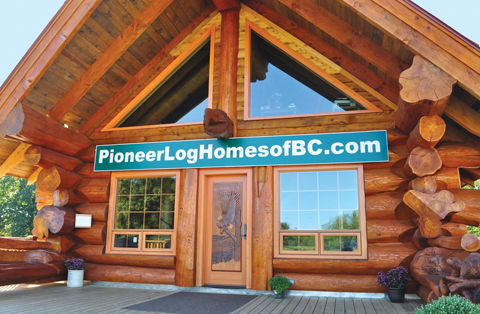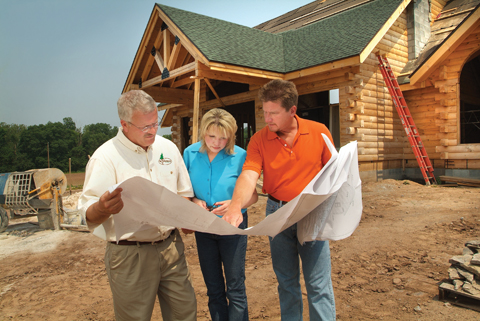Taking the notion of a log or timber home from idea to reality requires a great deal of patience and preparation. Like marriage, the decision to build should not be entered into lightly. So those who are wise choose to begin the process with a hefty round of research.
While the reasons for checking things out and asking questions before making decisions seem straightforward enough, it’s actually a process that requires some planning and effort in its own right—particularly today when so much information and, yes, misinformation is available. When you begin researching the log or timber home of your dreams, consider the sources of available information and just what each of them brings to the table.
Log and timber home sales professionals have developed their own opinions through the years and provide some valuable insights. Magazines, books, the Internet, home shows, model homes, seminars, and more options are enough to leave you breathless, but breathe deep, take a moment, and weigh what works for you.
“Magazines and photos,” advises Rob Ridgway, director of sales at Montana-based Pioneer Log Homes, on just where to start. “Concentrate on what you want the home to look like. Some folks want a rugged, rustic handcrafted home, and others are more attracted to the finished, smooth-paneled look of a milled D-log, for example.”
Charles Knight, co-owner of Missouri-based Liberty Log Cabins, LLC, says a log and timber home show is a great place to start. “A booth by booth examination of different companies allows you to ask questions of the sales representatives and get the details of how and why they do what they do,” he says. “This may be your last home, so make sure you have the answers.”

Timber Block
The Log and Timber Council of the National Association of Home Builders offers lots of information according to Jeremy Bertrand of Log Cabin Homes of America, Inc., located in North Carolina. “The Log and Timber Homes Council gives trusted information,” he reasons, “and it has a great library of information about various log home subjects.”
Still other sources have their place in the information spectrum. Such publications as Log Cabin Homes, including its popular and informative Annual Buyer’s Guide, provide a wealth of information that allows consumers to browse at their leisure, marking pages of pictures and floorplans for future reference.
“There are lots of pictures in magazines to help you decide on things,” comments Knight, “and while books and magazines are limited to generic answers they are a good starting point. Cut out the photos and drawings that you like and save them in a file.”
Knight further advises consumers to make phone calls and ask direct questions. Avoid simply accepting the canned responses, too. When someone says, “It’s in the catalog or book,” press for specifics. “Get the real answers! Talk one on one with real people.”
Prospective log or timber home owners have the advantage of exploring the Internet for options, visiting myriad sites without leaving home. Bertrand notes, “Design ideas, blogs, pictures, videos, and lots of information are there. Thanks to the Internet, so much information is available that building a home does not have to be a mystery. Thanks to social networks, customers can look up companies to evaluate their legitimacy and even see if there are complaints against them.”
Seminars and model homes are good sources of information, but Knight warns that these opportunities come with some limitations. “Everybody wants to put their best foot forward with a model home,” he says. “Go and see some actual construction and get the details. Seminars are good for a general overview; however, the real difference in log quality and style is found only with investigation.”

Pioneer Log Homes of BC
Bertrand agrees. “Model homes provide a peek into common construction practices and design ideas clients can use in their homes,” he relates. “But don’t judge the quality of a company’s product by their model home! Model homes should be kept in top-notch condition. Be sure to visit existing homes, lived-in homes, and homes over 10 years old to really gain a true understanding of the quality of a company’s product.”
Putting boots on the ground gives immediate perspective, and there is no substitute for allotting time between shows, model homes, actual completed construction, and log and timber homes that have been finished for a few years and weathered seasonal climate changes.
“Log home shows are notorious for feeling like you are drinking out of a firehose,” remarks Bertrand, “but because of the ability to meet so many suppliers of log packages, designers, and others, the shows are an incredible one-stop shopping resource—not to mention that some have free seminars and workshops on site that can educate people pretty quickly about certain topics.”
Throughout the process, prospective homeowners must keep their guard up. Checking references, verifying guarantees and warranties, and cultivating peace of mind help simplify the decision-making process.
“Talk to people at the log home companies. Grow a relationship based on trust,” recommends Ridgway. “Be wary of a company that claims their material or system is ‘THE BEST.’ That’s just plain wrong. There are a lot of good ways to build a quality log home and lots of different woods to use. We happen to use dry standing lodgepole pine and spruce because they work best with our system. There are many companies that supply high-quality pine, oak, or western red cedar structures. The finished home just looks different than ours. They all can make great homes. Choose the style of log home you want to live in and pursue that option first.”
Preparing for a major project and the investment of a lifetime is truly a daunting task. However, hours of research in the appropriate areas and with the appropriate tools will result in years of pleasurable living in the log or timber home that has progressed from a basic thought to a real, tangible masterpiece.

